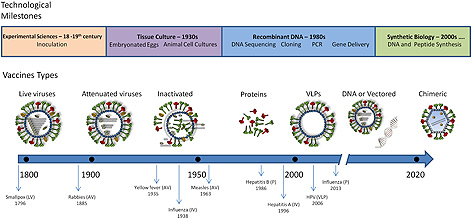Figure 1.

Schematic representation of the vaccine design evolution following the technological advancements. Inoculation was a standard procedure in the 18–19th centuries. The first vaccine against smallpox was introduced by Edward Jenner in 1796 and consisted in inoculating the live virus (LV) cowpox obtained from infected cattle. In the middle of the 20th century animal cell culture became a standard procedure to grow virus allowing the development of attenuated (AV) and inactivated (IV) vaccines. In the late 20th century the DNA recombinant technologies allowed to develop subunit vaccines based on presenting protein antigens (P and VLPs), coding for the antigens (DNA and vectored vaccines) or both. Further advances on genetic engineering originated a myriad of different vaccine designs such as chimeric vaccines still under development but holding great expectations.
